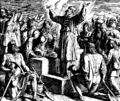Rhetoric facts for kids
Rhetoric is all about how we use language to convince or persuade people. It's like the art of speaking or writing in a way that makes others agree with you or understand your point of view. The word comes from ancient Greek and means "the art of speech."
Think of it as using words effectively. What works to convince someone in one place might not work in another, because different cultures use language differently. People can learn this skill. It's used by orators (public speakers), writers, and even in media like TV shows and advertisements.
Contents
History of Persuasion
How Rhetoric Started
Rhetoric first became important in Ancient Greece around 2,500 years ago. Back then, people would discuss and decide things by speaking in public places. For example, if someone was accused of a crime, speeches were made in court.
Because speaking well was so important, the Greeks and later the Romans wrote books about how to be a good speaker. Plato, a famous Greek thinker, wrote his ideas as conversations between different characters. The Romans, who learned a lot from the Greeks, also used public speaking to make decisions. Cicero was one of their most famous speakers. In Rome, these debates happened in the Senate or in the courts, not usually with all citizens.
Rhetoric Through the Ages
During the Middle Ages, rhetoric was taught in universities. It was part of a group of subjects called the trivium, which also included dialectic (logic) and grammar. These subjects, along with the quadrivium, made up the seven liberal arts that people studied.
For a long time, rhetoric was used to persuade people in public and political discussions, and also in legal courts. Sometimes, the words 'rhetoric' or 'sophism' are used in a negative way. They might suggest that someone is using words to mislead or spread propaganda. However, rhetoric is still very important in public life today. It's the art of convincing others.
Classical rhetoricians identified hundreds of rhetorical figures. Some of these are still used today, like metaphor (saying one thing is another), simile (comparing two things using "like" or "as"), and paradox (a statement that seems to contradict itself).
Rhetoric in the Modern World
Today, rhetoric is everywhere. Speeches on television, ideas in advertisements, or talks given to large crowds are all examples of rhetoric. They speak directly to people, aiming to persuade them.
Before World War II, radio and printed materials were powerful tools for rhetoric. Newspapers and books could persuade readers to agree with a certain point of view. Rhetoric doesn't just happen with a live audience; it can reach people through many different forms of media.
How Rhetoric Works
According to Aristotle, a famous Greek philosopher, there are three main ways to persuade people:
- Ethos: This is about the speaker's character. The speaker needs to seem good and trustworthy so that the audience believes them.
- Pathos: This involves making the audience feel certain emotions. By stirring their feelings, the speaker can get them into the right mindset to be persuaded.
- Logos: This is about the actual argument or proof given in the speech. It's the logical reasons and evidence that support the speaker's point.
Different Ways of Speaking
Cultural Differences in Rhetoric
Did you know that how people tell stories or argue can be different depending on their culture? This is called contrastive rhetoric. It means that even if people speak the same language, their cultural background can change their style of communication.
For example, a study in Australia looked at how students from different backgrounds wrote bedtime stories.
- Vietnamese students focused a lot on the characters and their relationships, using lots of dialogue.
- English-speaking students focused more on the story's plot and how it moved forward step-by-step.
- Arabic-speaking students focused on describing the setting and details of the story.
Another study in the USA looked at how Chinese and Russian students paraphrased texts.
- American students found it easy to put things into their own words.
- Chinese students found it harder, possibly because their schools focused more on exact memorization.
- Russian students also struggled because their schools usually asked them to describe what they read, not to give their own opinions.
The way people communicate is often shaped by their culture and how they learn.
What People Say About Rhetoric
Some clever things have been said about speakers and their rhetoric:
- Plato: "The orator is one who intends to mislead another, without being misled himself." (Meaning, a speaker might try to trick others without being tricked themselves.)
- Kant: "Oratory is the art of playing for one's own purpose upon the weaknesses of men, and merits no respect whatever." (Meaning, speaking can be used to take advantage of people's weaknesses, and that's not respectable.)
Related pages
- Hayakawa S.I. Language in thought and action. London: Allen & Unwin. ISBN: 0-04-400006-5
Images for kids
-
Ezra calls for the rebuilding of the temple in this 1860 woodcut by Julius Schnorr von Karolsfeld
-
Portrait of Erasmus of Rotterdam
See also
 In Spanish: Retórica para niños
In Spanish: Retórica para niños







